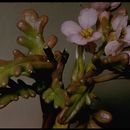en
names in breadcrumbs


Nile Valley North of Nubia (Delta), Mareotic Sector, North Sinai, Isthmic Desert, Galala Desert.
Annual.

Cakile maritima, sea rocket (Britain and Ireland)[3] or European searocket (North America), is a common plant in the mustard family Brassicaceae. It is widespread in Europe, North Africa and western Asia, especially on coastlines. It can now be found in many other areas of the world where it has been introduced. It is present on the west and east coasts of North America, where it has the potential to become an invasive species. This is an annual plant which grows in clumps or mounds in the sand on beaches and bluffs. The shiny leaves are fleshy, green and tinted with purple or magenta, and long-lobed. It has white to light purple flowers and sculpted, segmented, corky brown fruits one to three centimetres long. The fruits float and are water-dispersed.
It is a glabrous, succulent annual, with a slender or stout taproot. It has a branched stem which is prostrate or ascending, growing up to 15–45 cm (5.9–17.7 in) long. The lobed leaves,[4] are flesh-like and alternately spaced on the stem. They are different at the top and bottom of the stem; the lower leaves are obovate or oblanceolate, while the upper ones are oblong.[5] It blooms in the UK, between June and August.[4] The small flowers occur in shades of white, lilac-coloured or purple,[5][4] with 4 petals measuring up to 25 mm (0.98 in) across. Later it produces green maturing to brown, with short, stubby seed capsules. They contain two yellow or brown, smooth seeds.[5][4] The seed oil contains a high level of erucic acid.[6][7]
Due to its highly efficient antioxidant system,[8] it can withstand even high doses of Cadmium pollution.[9]
It was published and described by Giovanni Antonio Scopoli in 'Fl. Carniol.' edition 2, Vol.2 on page 35, in 1772.[2][10][11]
The Latin specific epithet maritima means "of the sea".[12]
Cakile maritima is native to temperate areas of North Africa, western Asia and Europe.[14]
It is found in Africa within Algeria, the Canary Islands, Egypt, Libya, the Madeira Islands, Morocco and Tunisia. In Western Asia, it is found in the Caucasus, Georgia, Iran, Israel, Syria and Turkey. In Eastern Europe, it is found in Estonia and Ukraine. In middle Europe, it is found within Belgium, Germany, the Netherlands and Poland. In Northern Europe, in Denmark, Finland, Iceland, Norway and the United Kingdom. In South-eastern Europe, within Albania, Bulgaria, Croatia, Greece, Italy, Montenegro, Romania, Serbia and Slovenia. In Southwestern Europe, within France, Portugal and Spain.[14] It is also widely naturalised outside of its native range, in North America.[14]
It grows on the foreshores near large dune systems,[5] and in shingle banks.[4] It is tolerant of salt spray and transient seawater inundation. It is pollinated by a wide range of insects, from Apis mellifera, Eristalis intricarius and Pieris rapae.[5]
As the seed oil contains a high level of erucic acid it can have pathological effects on the cardiac muscle of several animal species. However, orange-bellied parrots feed on its seed during their northward migrating journey from Tasmania and Australia.[5]
The leaves are edible, preferably cooked, and not eaten in great quantity.[15] The seed oil can be used for industrial applications.[7]
 Cakile maritima - MHNT
Cakile maritima - MHNT Cakile maritima, sea rocket (Britain and Ireland) or European searocket (North America), is a common plant in the mustard family Brassicaceae. It is widespread in Europe, North Africa and western Asia, especially on coastlines. It can now be found in many other areas of the world where it has been introduced. It is present on the west and east coasts of North America, where it has the potential to become an invasive species. This is an annual plant which grows in clumps or mounds in the sand on beaches and bluffs. The shiny leaves are fleshy, green and tinted with purple or magenta, and long-lobed. It has white to light purple flowers and sculpted, segmented, corky brown fruits one to three centimetres long. The fruits float and are water-dispersed.